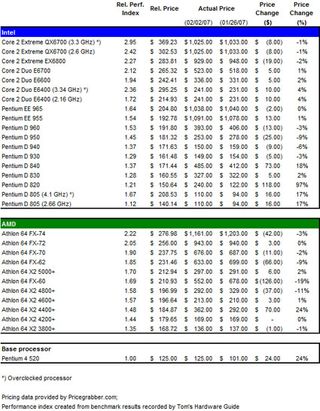Analysis: Retail prices of AMD processors continue decline
AMD undercuts Intel's price/performance on the low end

Click image to enlarge
On the whole, prices of Intel's Pentium D processors have been on a downward swing over the past weeks. However, this week, on the lowest end, the prices jumped. This, compounded with multiple weeks of price drops for AMD's 3800+, has actually given AMD a bit of a performance advantage over Intel in the low-end pricing arena.
The Pentium D 820 saw a huge jump this week, nearly doubling the average price from Pricegrabber.com over last week. Because of this, AMD's 3800+ and 4200+ offer a higher level of performance than the Pentium D 820, at a lower average e-tail price. This marks an important step for AMD as it tries to distinguish itself and find its way back in the market that Intel has closed in on. However, the Pentium D and especially the 90 nm D 800 has been in a phase-out for a while where drying up supply and jumping prices should not come as a surprise. The only 800 series left in Intel's official portfolio is the 820 model.
Going up on the performance line, though, there is a different story that is still unfolding. On the most part, we saw a decreasing trend for AMD's processors. The only oddball was the 4400+, which jumped 24% to log a $70 increase from $292 to $362.
However, the biggest change for AMD came with the one we've continuously said is the most volatile when it comes to pricing, and that's the (phased out) FX-60. It fell a considerable $126 from $678 to $552 this week. The FX-60 was the one that became the most overpriced, so this price decrease is critical for AMD.
Also, thanks to a $37 week-to-week decrease for the 4800+, it now offers more performance than the Pentium D 960 at a lower price. This level of performance is around the mid-end market, and shows how AMD must keep its prices very competitive in this area, since it has no real chance of competing in the high-end desktop market against Intel at this time.

Click image to enlarge
Stay On the Cutting Edge: Get the Tom's Hardware Newsletter
Join the experts who read Tom's Hardware for the inside track on enthusiast PC tech news — and have for over 25 years. We'll send breaking news and in-depth reviews of CPUs, GPUs, AI, maker hardware and more straight to your inbox.
Graphically, we can see that, at around the performance index levels of 1.35, 1.45, and 1.55, AMD offers the lowest price points. At 1.7, it is where it really starts to get undercut by Intel, though AMD does still offer acceptable, competitive pricing. However, when it gets to 2.0 and above, there is just no contest. Intel's prices beat AMD by at least $200 at this level.
Additionally, the FX-62 and the FX-60 are still quite overpriced. These prices need to come down at least $100 more, each, before AMD can really claim its stake in the mid-range performance level.

Click image to enlarge
What we can see when we split up Intel's data is an unusual trend, where Intel offers essentially a reflective image of its price/performance options for the Pentium D processors. It currently has a line of products that sell under its trendline, and a seemingly matching processor that offers less performance at a higher price.
This also really helps to show AMD's dominance in the low price, basic performance section of the graph. One other thing of note is that the Intel EX6800 has begun to fall in place by a little bit, after a $19 decrease this week. It has been on a trend to decrease ever since the QX6700 was officially released.
AMD is caught in an increasingly solid position in the lower end mainstream and entry-level desktop processor market. For consumers and system builder, of course that opens the door to potentially good deals in Q1/Q2: If it doesn't have to be the best possible performance, but still offer plenty of power for Vista, then there may be more value in your next PC than you have seen in many years.
Most Popular



